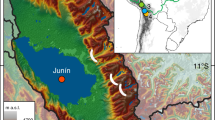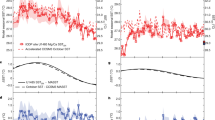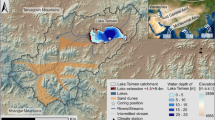Abstract
Replying to: De’er Zhang & Longhua Lu Nature 450, doi:10.1038/nature06338 (2007)
Zhang and Lu1 argue that Chinese historical climate records contradict certain of our interpretations2 based on Lake Huguang Maar sediment records. Interpreting these records as an indicator for winter monsoon winds and Chinese cave records as an indicator for summer monsoon rainfall3, we observed2 an inverse relationship between winter and summer monsoons on a millennial timescale over the past 16,000 yr. In sediments deposited during the period of Classical Chinese dynastic history, we found evidence for a temporal coincidence between winter monsoon strengthening and the terminations of important dynasties2. Extrapolating the inverse monsoon relationship to these multidecadal timescales, we suggested that reduced summer rainfall contributed to dynastic terminations, including that of the Tang (ad 618–907). Zhang and Lu1 challenge the validity of the summer/winter monsoon relationship on the grounds that historical records indicate that relatively cold winters tended to be associated with relatively wet summers over the period they considered. They argue that the Tang dynasty decline was associated with cold winters, in agreement with our findings2, but they find no evidence for rainfall changes having contributed to the decline of the Tang.
This is a preview of subscription content, access via your institution
Access options
Subscribe to this journal
Receive 51 print issues and online access
$199.00 per year
only $3.90 per issue
Buy this article
- Purchase on Springer Link
- Instant access to full article PDF
Prices may be subject to local taxes which are calculated during checkout

Similar content being viewed by others
References
Zhang, D. E. & Lu, L. H. Anti-correlation of summer/winter monsoons? Nature 450, 10.1038/nature06338 (2007)
Yancheva, G. et al. Influence of the intertropical convergence zone on the East Asian monsoon. Nature 455, 74–77 (2007)
Dykoski, C. A. A high-resolution, absolute-dated Holocene and deglacial Asian monsoon record from Dongge Cave, China. Earth Planet. Sci. Lett. 233, 71–86 (2005)
Zheng, J. et al. Precipitation variability and extreme events in eastern China during the past 1500 years. Terr. Atmos. Ocean. Sci 17, 579–592 (2006)
Ge, Q. et al. Winter half-year temperature reconstruction for the middle and lower reaches of the Yellow River and the Yangtze River, China, during the past 2000 years. Holocene 13, 933–940 (2003)
Author information
Authors and Affiliations
Rights and permissions
About this article
Cite this article
Yancheva, G., Nowaczyk, N., Mingram, J. et al. Yancheva et al. reply. Nature 450, E8–E9 (2007). https://doi.org/10.1038/nature06339
Published:
Issue Date:
DOI: https://doi.org/10.1038/nature06339
This article is cited by
-
Spatial patterns of precipitation anomalies for 30-yr warm periods in China during the past 2000 years
Acta Meteorologica Sinica (2012)
-
Climatic change and dynastic cycles in Chinese history: a review essay
Climatic Change (2010)
-
On linking climate to Chinese dynastic change: Spatial and temporal variations of monsoonal rain
Chinese Science Bulletin (2010)
-
Reply to the comment of Cheng et al.
Chinese Science Bulletin (2010)
Comments
By submitting a comment you agree to abide by our Terms and Community Guidelines. If you find something abusive or that does not comply with our terms or guidelines please flag it as inappropriate.



